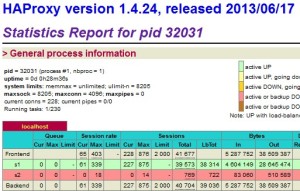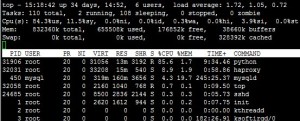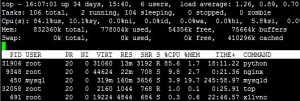在pcduino上对比haproxy和nginx的负载效果
安装haproxy
下载地址
http://www.haproxy.org/download/1.4/src/haproxy-1.4.24.tar.gz
安装如下
make TARGET=linux26 ARCH=arm PREFIX=/program/haproxy
make install PREFIX=/program/haproxy
配置如下:
global
log 192.168.1.132 local0
#log 127.0.0.1 local1 notice
#log loghost local0 info
maxconn 4096
chroot /program/haproxy
uid 0 #所属运行的用户uid
gid 0 #所属运行的用户组
daemon
nbproc 1
pidfile /program/haproxy/run/haproxy.pid
#debug
#quiet
defaults
log global
log 192.168.1.132 local3 #日志文件的输出定向
mode http #所处理的类别
option httplog #日志类别
option httpclose
option dontlognull
option forwardfor
option redispatch
retries 2 #设置多个haproxy并发进程提高性能
maxconn 2000
balance roundrobin #负载均衡算法
stats uri /haproxy-stats #haproxy 监控页面的访问地址
# 可通过 http://localhost:1080/haproxy-stats 访问
contimeout 5000
clitimeout 50000
srvtimeout 50000
listen localhost 0.0.0.0:1080 #运行的端口及主机名
mode http
option httpchk GET / #健康检测地址
server s1 192.168.1.132:9900 weight 3 check
server s2 192.168.1.80:8880 weight 3 check
简单操作如下:
启动服务:
# /program/haproxy/sbin/haproxy -f /program/haproxy/haproxy.cfg
重启服务:
# /program/haproxy/sbin/haproxy -f /program/haproxy/haproxy.cfg -st `cat /program/haproxy/logs/haproxy.pid` (没有换行)
停止服务:
# killall haproxy
#./haproxy -h 说明
-v 屏蔽版本
-vv 编译选项
-V 版本
-d 前台,debug模式
-db 屏蔽后台模式
-D daemon模式启动
-q 安静模式,不输出信息
-c 对配置文件进行语法检查
-s 显示统计数据
-l 显示详细统计数据
-ds 不使用speculative epoll
-de 不使用epoll
-dp 不使用poll
-sf
-st
安装nginx
下载地址
http://nginx.org/download/nginx-1.5.6.tar.gz
首先安装pcre。
ftp://ftp.csx.cam.ac.uk/pub/software/programming/pcre/pcre-8.33.tar.gz
然后是configure、make、make install。
最后做个软连接。
ln -s /usr/local/lib/libpcre.so.1 /usr/lib/
开始安装nginx编译参数如下
./configure –prefix=/program/nginx –user=root –group=root –with-pcre –with-select_module –with-poll_module –with-http_stub_status_module –with-http_ssl_module –with-http_realip_module –with-http_gzip_static_module
配置如下
user root root;
worker_processes 1;
pid logs/nginx.pid;
events {
use epoll;
worker_connections 5120;
}
http {
include mime.types;
default_type application/octet-stream;
server_tokens off;
log_format main '$remote_addr - $remote_user [$time_local] "$request" '
'$status $body_bytes_sent "$http_referer" '
'"$http_user_agent" "$http_x_forwarded_for" "$request_time" '
'"$upstream_cache_status"';
access_log logs/access.log main ;
sendfile on;
keepalive_timeout 120;
tcp_nodelay on;
tcp_nopush on;
client_header_buffer_size 128k;
large_client_header_buffers 4 64k;
reset_timedout_connection on;
proxy_ignore_client_abort on;
######################################
upstream deploy_tool {
server 192.168.1.132:9900;
}
server {
listen 80;
server_name 192.168.1.132;
location / {
proxy_pass_header Server;
proxy_redirect off;
proxy_set_header X-Real-IP $remote_addr;
proxy_set_header X-Forwarded-For $proxy_add_x_forwarded_for;
proxy_set_header Host $http_host;
client_max_body_size 150m;
proxy_connect_timeout 2000;
proxy_send_timeout 2000;
proxy_read_timeout 300;
access_log off;
proxy_pass http://deploy_tool;
}
location /status {
stub_status on;
access_log off;
auth_basic_user_file /lnmp/nginx/conf/htpasswd;
}
}
}
WEB项目使用我的部署工具,只是连接到首页。python使用2.7。压力工具就是写了用urllib2多线程获取页面的代码,并发150个。测试结果如下:
haproxy:


nginx:


结论:
如果只是简单反向连接,两者效率差不多。haproxy后端检测效果不错,对长连接的处理也很好,可做mysql等其他服务器的负载工作。nginx有更强大的模块,如缓存、uwsgi等功能一起用,nginx就方便了很多。以后WEB的服务使用nginx,其它需要负载的使用haproxy。
发表评论